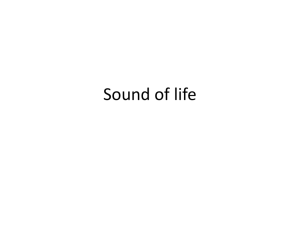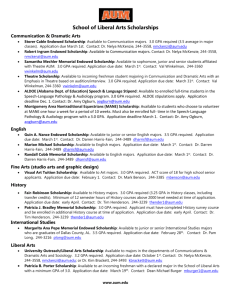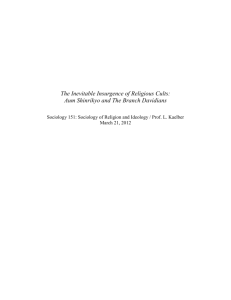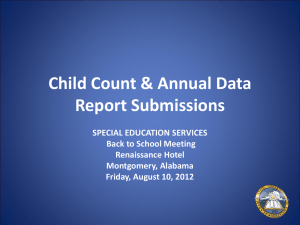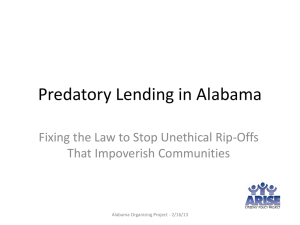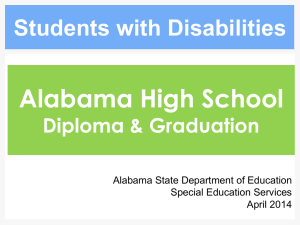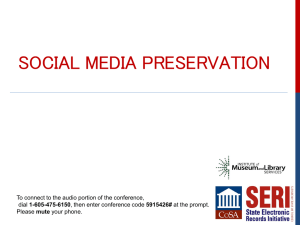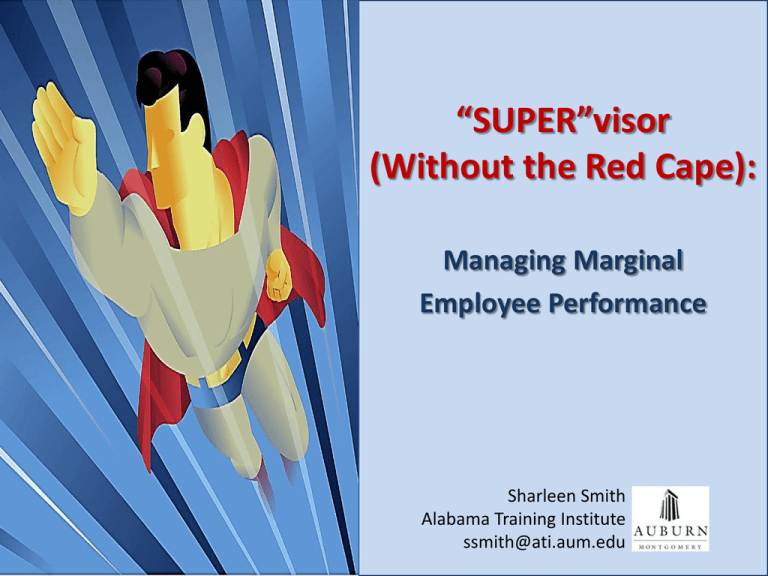
“SUPER”visor
(Without the Red Cape):
Managing Marginal
Employee Performance
Sharleen Smith
Alabama Training Institute
ssmith@ati.aum.edu
Copyright ©, 2010 AUM Alabama Training Institute, All Rights Reserved
Initial Thought
For a manager to be perceived
as a positive manager,
they need a four to one
positive to negative contact ratio.
Ken Blanchard
Copyright ©, 2010 AUM Alabama Training Institute, All Rights Reserved
This is a problem!
One of the tests
of leadership
is the ability
to recognize a problem
before
it becomes an emergency.
Arnold Glasgow
Copyright ©, 2010 AUM Alabama Training Institute, All Rights Reserved
Major Causes
of
Performance Problems
for
Employees
Copyright ©, 2010 AUM Alabama Training Institute, All Rights Reserved
Causes of Performance Problems
Lack of Knowledge or Skills
• Does the employee have the requisite skills, abilities and aptitudes
to perform the job?
• Did the employee have experience in the duty while in past jobs?
• Has the employee attended an orientation by the agency or
supervisor?
• Has the employee received informal on-the-job training or time to
practice?
• Has the employee received formal or certification training to do the
job?
o On-the-job training with peer or supervisor
o Traditional training courses
o Mentoring within the organization
Copyright ©, 2010 AUM Alabama Training Institute, All Rights Reserved
Causes of Performance Problems
Expectations or Requirements
Have Not Been Adequately Communicated
•
•
•
•
Does the employee know what is expected of the position?
Has the employee been given a performance appraisal plan?
Does the employee even know there is a problem?
Have you talked to the employee about specifics of the issue(s)?
o
o
o
o
o
Conduct “coaching session”
Outline the poor performance
Discuss how the employee will correct the problem
Discuss how you will assist
Provide follow-up
Copyright ©, 2010 AUM Alabama Training Institute, All Rights Reserved
Causes of Performance Problems
Poor Organizational Skills
• Does the employee produce the correct results but the manner is
unorganized?
• Does the employee easily complete tasks but not in a timely
manner?
• Does the employee’s office or work area look disorganized or
chaotic?
o Send the employee to training
o Help the employee one on one
Copyright ©, 2010 AUM Alabama Training Institute, All Rights Reserved
Causes of Performance Problems
Lack of Resources
• Do working conditions support good performance?
• Does the employee have the necessary tools, equipment and
resources?
• Are there enough human resources to assist?
• Does the employee have an environment that supports
performance?
• Are there other people who make the work punishing or hostile?
o Ask the employee
o Seek input from other employees in similar positions
o Conduct a thorough examination of the environment
Copyright ©, 2010 AUM Alabama Training Institute, All Rights Reserved
Causes of Performance Problems
Inefficient Work Flow or Process
•
•
•
•
Are the standards unrealistic?
Does the process need improvement?
Have you conducted a business process audit?
Have employees brought ideas to you regarding more efficient
ways of working?
• Have things always been “done this way” and you never stopped
to think of a better way?
o
o
o
o
Conduct a work flow analysis
Ask the employee
Ask employees who are in similar positions
Ask employees who were formally in the position
Copyright ©, 2010 AUM Alabama Training Institute, All Rights Reserved
Causes of Performance Problems
Insufficient Supervision
•
•
•
•
o
o
o
o
Is good performance rewarded or punished?
Is poor performance rewarded?
Is the employee being treated fairly?
Does the system support good performance?
Examine your interactions with the employee
Monitor your daily communications with the employee
Determine whether you treat the employee as you do others
Use personnel systems properly to support performance
Copyright ©, 2010 AUM Alabama Training Institute, All Rights Reserved
Causes of Performance Problems
Lack of Personal Motivation
• Does the employee have the proper attitude (desire)?
• Does an issue exist in the employee's personal life that may
contribute to poor performance?
• Is the employee's morale preventing the employee from
successfully applying skills and abilities?
o
o
o
o
Talk to the employee about the specific performance issue
Be straightforward about the consequences of non-performance
Encourage the employee to visit the EAP program
Do not ask if there is a personal issue
Copyright ©, 2010 AUM Alabama Training Institute, All Rights Reserved
PROBLEM EMPLOYEE
I Can't
I Won't
I Can
I Will
Find the negative cause
and
coach the need.
This is the
employee’s choice.
Use coaching,
counseling and
discipline system.
Copyright ©, 2010 AUM Alabama Training Institute, All Rights Reserved
Responsibilities
of the
Supervisor
Copyright ©, 2010 AUM Alabama Training Institute, All Rights Reserved
Definitions
of
Performance:
• What is the employee to accomplish?
• At what level is the employee to perform?
• How will you measure the employee’s performance?
Copyright ©, 2010 AUM Alabama Training Institute, All Rights Reserved
Supervisory Responsibility - Counseling
Informal Counseling
Session
•
•
•
•
•
Meet with the employee
Discuss performance problems
Ask how the employee will solve the problem
Determine how you will assist
State the consequences
Copyright ©, 2010 AUM Alabama Training Institute, All Rights Reserved
Supervisory Responsibility - Counseling
Two Minute Challenge
•
•
•
•
•
State what you observed
Wait for a response
Remind them of the goal
Ask for a specific solution
Agree on the solution
Copyright ©, 2010 AUM Alabama Training Institute, All Rights Reserved
Supervisory Responsibility - Counseling
Written Action Plan
•
•
•
•
•
State the problem
Explain how it needs to be corrected
Set a time frame for monitoring behavior
List any assistance you will provide
Set a meeting date for the end of the period
Copyright ©, 2010 AUM Alabama Training Institute, All Rights Reserved
Supervisory Responsibility - Feedback
Effective feedback can...
o Direct behavior in a desired direction
o Influence how goals are set for improvement
o Reinforce good behavior by providing information
about what went well so it can be repeated
o Clarify expectations for performance
o Help identify what needs to be improved and how
to improve it
o Increase motivation to perform well
Copyright ©, 2010 AUM Alabama Training Institute, All Rights Reserved
Supervisory Responsibility - Feedback
o Help employees know the rules in the organization-what behavior is accepted and what is not accepted.
o Help employees feel like they are in control of
outcomes.
o Help employees feel they are involved and play a
central role in the work of the department.
o Help managers understand contingencies affecting
employee performance.
o Help employees and managers make better choices
and decisions.
o Help save the organization money.
Copyright ©, 2010 AUM Alabama Training Institute, All Rights Reserved
Reactions to Feedback
Some negative reactions an employee may have to
constructive feedback include:
o
o
o
o
o
Defensiveness
Anger
Denial
Passiveness
Despair
Copyright ©, 2010 AUM Alabama Training Institute, All Rights Reserved
Strategies for Responding
to
Negative Reactions
o Create a safe environment. Focus on the issues, not the
person.
o Concentrate on behaviors.
o Maintain non-threatening body language.
o Use active listening.
o Resist the temptation to respond with your own negative
emotions. Keep a steady, even tone.
Copyright ©, 2010 AUM Alabama Training Institute, All Rights Reserved
Strategies for Responding
to
Negative Reactions
o
o
o
o
o
o
Allow for periods of silence.
Restate your confidence in the employee.
Clearly state what is expected next.
Help employees believe they can change.
Consider a "cooling off" period.
Don't minimize reactions.
Copyright ©, 2010 AUM Alabama Training Institute, All Rights Reserved
Supervisory Responsibility - Documentation
•
•
•
•
Legalities
Location for documentation
ABCs of documentation
Objective v. Inferential documentation
Copyright ©, 2010 AUM Alabama Training Institute, All Rights Reserved
Document Performance Behaviorally
A supervisor needs to…
Understand the difference between a behavior and an
inference.
Recognize that good feedback is behavioral rather than
inferential.
Focus on behavior, which allows managers to provide
feedback that others can use to leverage their strengths,
or to improve in areas where they need development.
Copyright ©, 2010 AUM Alabama Training Institute, All Rights Reserved
Document Performance Behaviorally
Our tendency as supervisors is to classify employees and to
make judgments about their intent or motivation to perform
well.
We may describe someone who performs effectively as:
“She's a hard worker. She’s a real team player.”
or
“He's got a great attitude. He's a real asset.”
Copyright ©, 2010 AUM Alabama Training Institute, All Rights Reserved
Document Performance Behaviorally
Or, alternatively, we may describe ineffective performers in
the following ways:
"His work is sloppy.
He doesn't care whether it is accurate or not.“
or
"He's lazy and unhelpful."
Copyright ©, 2010 AUM Alabama Training Institute, All Rights Reserved
Final Thought
Too many leaders act as if the sheep
...their people...
are there for the benefit of the shepherd,
not that the shepherd
has responsibility for the sheep.
Ken Blanchard
27
Copyright ©, 2010 AUM Alabama Training Institute, All Rights Reserved

